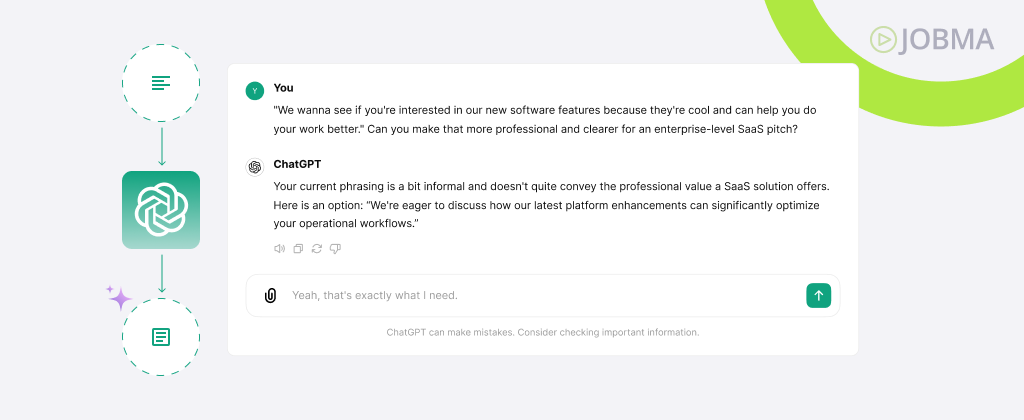Build and Master the Communication Skills Employers Value Most
The job market is enamored with hard skills. As applicants, we optimize resumes, chase certifications, and stack up technical proficiencies like trading cards. But if you’re aiming to stand out as a candidate and grow within a team, you must confront an inconvenient truth: technical ability gets you through the door, but communication earns you a seat at the table. So, whether you’re aiming to land your first role or grow in your current one, how well you communicate will play a defining role in your success.
According to the NACE’s Job Outlook 2025 report, communication ranks among the top five attributes employers look for on a new graduate’s resume. Three-quarters of recruiters surveyed in the report stated that they actively seek candidates who demonstrate strong communication skills, right alongside problem-solving abilities and teamwork.

If you can’t clearly express ideas, give feedback, raise concerns, or share your vision, your other capabilities may struggle to gain recognition. So, what makes communication such a powerful skill in the workplace? And how can you cultivate it to set yourself apart?
Let’s unpack what effective communication looks like and why it’s often the deciding factor in long-term career success.
Why Communication Matters at Work
Hard skills and other soft skills like motivation and collaboration are table stakes. Communication, however, is the thread that ties all the other skills together. Regardless of your role or industry, your success often hinges on your ability to articulate, listen, and adapt. In practice, maintaining a consistent tone of voice ensures your message resonates clearly and authentically across different communication channels.
97% of employees believe that communication impacts their tasks daily. If communication breaks down, it becomes difficult to lead teams, write briefs, pitch ideas, negotiate, resolve conflicts, or manage clients. Even the strongest skills can be easily overlooked if you aren’t able to communicate effectively. Your ability to communicate can be a deciding factor between progress and friction. For instance, a teammate who outlines expectations clearly, responds promptly, and follows through fosters trust and momentum. Meanwhile, someone who sends vague updates, ignores follow-ups, or avoids difficult conversations can unintentionally derail projects. The difference often comes down to how well you communicate.
Strong communication promotes alignment, reduces misunderstandings, and contributes to a more positive workplace culture. Poor communication, on the other hand, can be costly. One survey found that 28% of employees cited poor communication as the reason for missed project deadlines. It also impacts productivity, job satisfaction, and reduces trust in leadership and the team.
The Four Types of Workplace Communication
Communication is not monolithic – it shows up in different forms, and being consistent across them matters. Being articulate in meetings but unclear in emails or great in writing but tone-deaf in person can create confusion. To master communication skills, you need to be consistent across these four different types:
Verbal Communication: This is how your presence is heard and felt in the room. It consists of any type of communication transmitted through spoken words, such as speaking clearly in meetings, presentations, one-on-one interactions, or quick sync with your manager. In virtual meetings, where tone and clarity can easily get lost, English learning tools can also help you improve pronunciation, phrasing, and confidence, ensuring your message comes across clearly and effectively.
Nonverbal Communication: According to Mehrabian’s Rule, communication is determined by 55% body language, 38% tone, and 7% actual words. This means your tone, posture, eye contact, and facial expressions often say more than your words do. A calm, open posture and engaged eye contact can enhance your message and create a connection.
Written Communication: This is where modern work happens – emails, internal instant messaging for business, reports, and briefs. But it’s not just about using the right grammar – it’s about tone, structure, and purpose. Using an email checker can help ensure your messages are clear, professional, and error-free before hitting send.
Visual Communication: It involves using any type of visual cue to get the message across and enhance understanding, such as charts, graphs, and visual aids to support. They shape how information is consumed and understood. Good visual communication removes friction. You could also highlight how tools like virtual office software help streamline communication across all four types in remote or hybrid workplaces.

How to Be A Better Communicator
Like any skill, communication improves with practice and self-awareness. Here’s how to sharpen yours:
Tune in to Nonverbal Cues: Body language, facial expressions, and tone often speak louder than words. So, when in conversation, pay attention to your posture, eye contact, gestures, and even the pace of your speech, as these can shape how your message is received. In case of written communication, such as texts and emails, tone doesn’t always come through, so if you’re struggling to get through, suggest a call or a quick video chat. You can also ensure your emails reflect professionalism and clarity by setting up a proper iPhone signature that reinforces your tone and contact information.
Use Gen AI To Refine Your Message: Clear communication sometimes requires another pair of eyes. Generative AI tools like ChatGPT, Gemini, Rewording tool, etc., can help you refine messages and emails for enhanced clarity and professionalism. Whether you’re drafting a difficult email, rewording a message to strike the right tone, or preparing talking points for a meeting, these tools can act as helpful editors. Use it to review grammar, tighten phrasing, or simulate how your message might be received. These tools can help you communicate more effectively.

Listen Actively: Great communicators are often great listeners. Practice active listening by focusing on understanding the speaker’s intent and emotions behind their words. Show that you’re engaged, whether that’s by nodding along, maintaining eye contact, or saying things like “Can you tell me more about that?”. Ask follow-up questions, and avoid interrupting. Even small actions like putting your phone away can signal that you value what the other person is saying.
Be Present in Meetings: Preparation helps you participate with purpose. Reviewing past notes, revisiting action items, and noting down questions beforehand can make your contribution more impactful. When there’s an agenda shared, taking a few minutes to review it can help you stay aligned. Using an AI note taker can help organize key points and ensure nothing is missed during the discussion. Even small actions like arriving on time, staying engaged, and following up afterwards can signal that you value the discussion and the outcome.
Reflect & Improve: Every conversation may not go as you intended, and that’s part of the learning curve. If something didn’t go well – an email didn’t get the response you expected, or a conversation didn’t flow well, pause and reflect on it. Tools like grammarIn or ChatGPT can help you rephrase and review your tone and clarity. Keep a running note of what worked and what didn’t to build self-awareness.
Provide & Seek Feedback: Good communication takes input. If you’ve been invited to share feedback, aim to keep it constructive and helpful. Be open about receiving it as well. A simple check-in with a peer, like “What’s one thing I could do better when I present?” can reveal blind spots and open the door to growth. Thoughtful feedback, both given and received, builds stronger relationships and helps you grow faster. Conducting an employee engagement survey can also provide valuable insights into team satisfaction and areas for improvement.
Benefits of Effective Communication
Increased Productivity
Clear and open communication builds trust, enhances collaboration, and makes employees feel more connected. When teams are connected, it increases productivity by 20-25%. 64% of organizations now rank communicating strategy, purpose, and values as a top priority because when employees know what they’re working toward, they execute with greater speed and focus.
Builds Trust & Strengthens Collaboration
Team dysfunction stems from misalignment, silence, and poor communication. In fact, 86% of corporate executives and employees cite that lack of communication and collaboration as the main source of workforce failure. On the contrary, strong and effective communication builds trust. Employees who genuinely feel heard in their workplace are 4.6x more likely to feel more empowered and perform their best. When there is better communication, it bridges the collaboration gap between the team.
Saves Time and Money
Miscommunication can be costly, and it can arise from something as simple as being out of the loop or an unclear email. 28% of employees cited poor communication as the reason projects don’t get delivered on time. It can slow down work, increase errors due to missed details, and tank the productivity level. The impact is staggering – among large corporations surveyed in the US and UK, employee misunderstandings, ranging from unclear job functions to misinterpreted policies, cost an estimated $37 billion annually. For intestines, email marketers can leverage tools such as timetoreply, zendesk to track their team response time and make necessary adjustments to increase productivity by effective communication.
Final Thoughts: Strengthen Your Communication for Success
Communication skills go beyond what you say – they reflect how well you listen, empathize, and connect. They’re the foundation of how relationships are built, teams are led, and ideas come to life. By honing these skills, you become someone others turn to. Strong communicators get noticed, earn credibility, and build influence over time. So, whether you’re aiming for career growth, more visibility, or stronger workplace relationships, improving how you communicate is one of the smartest investments you can make.




